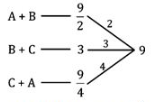 Introduction
Introduction
Work is defined as the amount of job assigned or the amount of job actually done. Work is always considered as a whole or 1. Work-based problems are more or less related to time speed and distance. The article IBPS RRB Time and Work Quiz Day 1 provides information about Time and Work, an important topic of Quantitative Aptitude section. Consists of different types of questions with solutions useful for candidates preparing for different competitive examinations like RRB ALP/Technical Exams/Junior Engineer Recruitment Exams, SSC, IBPS PO Exams and etc.
 Quiz
Quiz
Q1. A and B together can complete a job in 16 days. Both B and C, working alone can finish the same job in 12 days, A and B commence work on the job, and work for 4 days, whereupon A leaves, B continues for 2 more days, and then he leaves too, C now starts working and finishes the job. How many days will C require?
- A. 5 days
B. 8 days
C. 3 days
D. 7 days
- A. 13 days
B. 19 days
C. 5 days
D. 12 days
- A. 225
B. 220
C. 230
D. None of these
- A. 5 days
B. 6 days
C. 8 days
D. 10 days
- A. 4
B. 5
C. 10
D. 12
Q1. A and B working together can do a piece of work in 4 1/2 hours. B and C working together can do it in 3 hours. C and A working together can do it in 2 1/4 hours. All of them begin work at the same time. Find how much time they will take to finish the piece of work?
- A. 3 hours
B. 2 hours
C. 2.5 hours
D. 1 hours
- A. 5 days
B. 6 days
C. 8 days
D. 10 days
- A. 1 [latex] \frac {1}{2} [/latex] days
B. 3 [latex] \frac {2}{3} [/latex] days
C. 3 days
D. 2 [latex] \frac {1}{2} [/latex] days
- A. 20 days
B. 25 days
C. 10 days
D. 15 days
- A. 14800
B. 16400
C. 16000
D. 17200
Q1. A is twice efficient as B. A and B together do the same work in as much time as C and D can do together. If the ratio of the number of alone working days of C to D is 2:3 and if B worked 16 days more than C then no of days which A worked alone?
- A. 18 Days
B. 20 Days
C. 30 Days
D. 36 Days
- A. 1 Day
B. 1.5 Day
C. 2 Days
D. 2.5 Days
- A. 21 Days
B. 21 [latex] \frac {7}{8} [/latex] Days
C. 21 [latex] \frac {5}{6} [/latex] Days
D. 21 [latex] \frac {4}{9} [/latex] Days
- A. 9 Days
B. 10 Days
C. 12 Days
D. 15 Days
- A. 7 Days
B. 12 Days
C. 14 Days
D. 21 Days
Other Articles
 Study Guide
Study Guide
| Competitive Exams - Study Guide | ||
|---|---|---|
| Category | ||
| Quantitative Aptitude | Reasoning Ability | General Awareness |
| Computer Awareness | English Knowledge | Banking Awareness |
| General Science | World of Words | Descriptive Test |
 Exams
Exams
| Competitive Exams - Entrance Exams | |||
|---|---|---|---|
| Category | Notification | ||
| UG | NSTSE 2020 | RIMC Admission 2020 | NEET UG 2020 |
| AEEE 2020 | PESSAT 2020 | ||
| Graduate | VTUEEE 2020 | JEE Main 2020 | GPAT 2020 |
PG |
CSIR UGC NET 2019 | UUEE 2020 | LSAT 2020 |
| Click Here For – All India Entrance Exam Notifications | |||
 Daily CA
Daily CA
 Job-Alerts
Job-Alerts
 SP Quiz
SP Quiz
| Competitive Exams - Practice Sets | |
|---|---|
| Category | Quiz |
| Reasoning Ability | Seating Arrangement |
| Quantitative Aptitude | Compound Interest |
| General Awareness | General Awareness |
 GK
GK
| General Knowledge for Competitive Examinations | |
|---|---|
| Topic | Name of the Article |
| GK - World | Intelligence Agencies |
| Interpol Member Countries | |
| GK - India | Economy Basics |
| Sangeet Natak Akademi Awards 2019 | |
| GK - Abbreviations | International Organizations Abbreviations |
| GK - Banking & Insurance | Indradhanush Strategy to Revamp PSU Banks |
| Basel Norms | |
| GK - Science & Technology | Measuring Devices |
| IBM IIT Bombay AI Research | |






